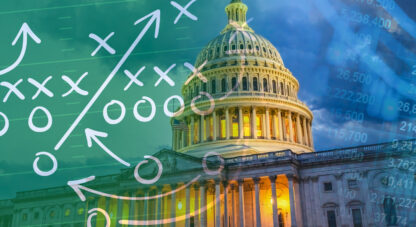The “Unpleasant” Tsunami
This week, market action was primarily dominated by two factors: the developing “baby-bubble” in generative artificial intelligence-linked stocks and the highly erratic headlines over the ongoing debt ceiling debate in Washington. Throughout the week, evolving headlines on debt ceiling developments triggered constant swings in market sentiment. When headlines increased fears over a possible default, prices slid lower. When optimism prevailed and hope inspired all, markets celebrated by shifting gears into rally mode. Across markets and individual stocks, price performance varied widely. The debt ceiling drama certainly drove widespread volatility across the market. But whether an index or individual stock ended up, down, or sideways seemed to depend chiefly on whether it was a perceived beneficiary of the generative artificial intelligence craze now captivating the imagination of Wall Street.
After market close on Wednesday, chip-making giant Nvidia Corp surged 25% after projecting much higher sales figures for July than analysts had anticipated. Better-than-expected sales projections always excite investors, but what really set the stock ablaze, along with any AI related tech names more broadly, was that management attributed higher chip demand to a generative artificial intelligence boom that started with the launch of OpenAI’s ChatGPT in November. In the new AI baby-bubble, the imagination knows no bounds and the sky is the limit. With generative AI enthusiasm surging, Nvidia’s stock set a new record on Thursday for the largest one-day increase in market capitalization for any company in market history.
Since the Fed’s rate hiking cycle began, the market has been absolutely starved of a bullish narrative of sufficient magnitude to truly captivate the minds of speculative investors. AI has delivered that narrative, and anything tech related with even a remote connection to the AI theme seems inclined to rally and rally hard. At long last, markets have found a new momentum bubble to ride, and market participants are piling in. This is not yesteryear’s FOMO, or “fear of missing out.” This craze should really be described as POMO, or “panic of missing out.”
Market indexes with tech/AI exposure are certainly benefiting, but, more broadly and under the surface, price action in stocks has largely been AI-related names up, everything else down. To understand the tech-driven nature of the current market rally, consider the extremely divergent weekly performance of the tech-heavy Nasdaq 100, which was up 3.59%, compared to the Dow Jones Industrial Average, which was down 1%.
This uncharacteristically binary market is the result of frenzied speculation that a global AI arms race will create an insulated island of AI-related tech firm beneficiaries that will soar while the looming credit crunch slices and dices companies in other sectors of the economy. Markets have never experienced such a large divergence in tech outperformance over the rest of the market outside of two instances during the final throes of the tech bubble and subsequent bust era in the year 2000. One of the instances was the Nasdaq’s last thrust higher into its final blow-off bubble peak that ultimately marked a 15-year high for the index. The second instance soon followed amid one of Nasdaq’s most impressive bear market rallies after the bubble had already burst and the bear market collapse was already underway.
Valuations in AI-themed companies have already gone full bubbly. Following Nvidia’s mid-week surge, the stock is now trading at well over 30x 2024 sales estimates. That is not sales net of expenses (earnings), that’s just sales—and that’s just absurd. For perspective, the S&P 500 index’s highest ever price-to-sales multiple was 3.17x at the all-time high of the “everything bubble” in 2021.
Generative AI is a massive new player on the social, economic, and market playing field. To be sure, the market phenomenon that is this AI narrative has officially arrived, and with it the newest “baby bubble” within the market has been born. However, hype and hysteria aside, the AI story isn’t in any conceivable way a simple one.
Before concluding that AI is the bubble that lifts all boats, consider findings released by Goldman Sachs and its team led by chief economist Jan Hatzius. According to Hatzius, “using data on occupational tasks in both the US and Europe, we find that roughly two-thirds of current jobs are exposed to some degree of AI automation, and that generative AI could substitute up to one-fourth of current work. Extrapolating our estimates globally suggests that generative AI could expose the equivalent of 300 million full-time jobs to automation.”
To put that 300 million potential job loss number in perspective, according to estimates from the International Labour Organisation (ILO), the 2020 Covid lockdowns that shuttered non-essential work in economies around the globe translated to a temporary loss of 255 million full-time jobs globally. This is an unbelievably complex developing situation with ramifications and implications that extend far beyond the domain of stock prices. Generative AI provokes profound social, political, economic, and philosophical considerations. While this won’t play out overnight as Covid lockdowns did, generative AI is happening, and it’s happening much faster than expected.
Meanwhile this week, the PCE inflation gauge, the Fed’s preferred inflation metric, came in hotter than expected. Core PCE (excluding food and energy) came in at 4.7% year-over-year vs. last month’s 4.6%. Headline PCE climbed to 4.4% vs. 4.2% last month. The hotter-than-expected inflation data has caused renewed speculation that the Fed may actually raise interest rates by another 25 basis points at the upcoming June 14th FOMC meeting. A little over a month ago, expectations for another hike were zero. As of Friday, market-based expectations favored a 60% probability of another hike. The increasing possibility of another Fed rate hike implies the diminishing possibility of any immediate Fed rate cuts. Along with this hawkish repricing of rate expectations we are also seeing Treasury yields on the rise and the dollar marching higher again. All told, the effect is that financial conditions are starting to tighten again.
This renewed tightening of financial conditions is occurring amid a still-vulnerable banking sector—which Former Dallas Federal Reserve Bank head Robert Kaplan warned this week is entering the “third phase” of crisis. Kaplan said, “bank leadership is very aware that the economy is slowing, and that we are likely about to enter a challenging credit environment… As a result, they are turning to shrinking their loan books, finding places to pull back on existing loans and future loan commitments.” He continued, “this is relentlessly going on beneath the surface,” and “this is making it much harder for small and midsized businesses to get and keep their bank loans.”
As HAI has pointed out in the past, as the credit crunch described by Kaplan manifests, the hit to small and mid-sized businesses will likely be powerful. That hit to small and mid-sized businesses is expected to ultimately flow through to small and mid-sized company employment. Such companies—those with less than 500 employees—are entirely responsible for job growth in America. If small and mid-sized business employment cracks, it’ll be a hard landing without landing gear for the economy and stocks. Unless tech and generative AI’s speculative rocket launch can fully escape the strong gravitational pull of an economy in credit crunch, the group’s exceptional recent outperformance may end as it did in the tech bubble – with a dramatic catch-down to reality.
Meanwhile, as bipolar market sentiment whips around on every new debt ceiling debate headline, first ballot hall of fame investor Stanley Druckenmiller recently captured the essential heart of the issue that, tragically, so few are attuned to. Druckenmiller suggests that on the debt issue, people are missing the forest for the trees. As the legendary investor put it, “all this focus on the debt ceiling instead of the future fiscal issue is like sitting on the beach at Santa Monica worrying about whether a 30-foot wave will damage the pier when you know there’s a 200-foot tsunami just 10 miles out.”
Druckenmiller’s 30-foot wave that could damage the pier refers to market fears that a temporary technical default will hit stocks and bonds if the Republicans and Democrats can’t reach an agreement to raise the debt ceiling before the looming X-date. So, what’s the “200-foot tsunami” we should be far more concerned with?
Republicans and Democrats are arguing over what is nothing short of a drop in the bucket compared to the country’s $31.8 trillion national debt, $6.2 trillion of spending, and $1.6 trillion and rising deficit. When we consider that the proposed spending cuts being vigorously argued over are increasingly less than what’s being added to the deficit from higher debt interest payments resulting from Federal Reserve interest rate hikes, we have to consider that we may be past the point of realistic hope for a fiscal recovery.
As Druckenmiller explained, “If you wanted to fix the fiscal situation today without touching entitlements, you’d have to raise taxes 40% tomorrow morning and keep them there forever or cut spending tomorrow morning by 35% and keep it there forever.” Needless to say, politicians and most market participants are intensely focused on the 30-foot wave. Meanwhile, no one is even thinking or talking about addressing the 200-foot tsunami. Practically speaking, we are racing toward the point where the only options are nominal debt default or renewed Fed money printing to monetize the debt. Regardless, either the debt or the value of the dollar must be sacrificed.
In June, Fed Chairman Powell said in testimony before the House Financial Services Committee that US government debt is on an “unsustainable path.” In his testimony, he warned, “the US is on an unsustainable fiscal path, meaning the debt is growing faster than the economy… By definition, that is unsustainable.”
Unsustainable fiscal policy leads directly to unsustainable monetary policy. If the Fed prints the money to monetize debt rather than default, it fans the flames of inflation. If it tries to raise interest rates to fight inflation, perversely, it grows the deficit with even more debt interest expense, and in turn accelerates the entire doom loop by needing to print even more money to monetize the debt. As Powell himself said: unsustainable, by definition. That’s the 200-foot tsunami. We may be past the point of no return, in which case the only remaining options are to default or inflate. If the bond market sees that 200-foot wave coming, we’ll have a Treasury market crisis that inevitably spreads into everything else.
After the gold standard was replaced by the Fed standard, gold—among other things—became financial insurance against policy malpractice. Unsustainable policy is a bull market-maker for gold, and with late-inning unsustainability now manifest in both fiscal and monetary policy, HAI expects that, over time, the price of financial insurance will get more expensive as the price of gold continues to rise.
In speaking of the United States and reflecting on Memorial Day, Peabody Award recipient Elmer Davis famously said, “This nation will remain the land of the free only so long as it is the home of the brave.”
Well, a fiscal and monetary policy of unsustainability that results in amassing an endlessly growing pile of national debt at an ever-accelerated pace is neither brave nor morally defensible. Given the threat of the 200-foot tsunami, the danger of a recessionary credit crunch, and the myriad complications and intimidating challenges involved in navigating a generative AI revolution, America desperately needs to rediscover a functioning moral compass, wisdom, and bravery. For policy makers, there’s no time like the present to find and display the character needed to best confront the trials ahead.
Famed Austrian economist F.A. Hayek warned that “unless we mend the principles of our policy, some very unpleasant consequences will follow.” If Stan Druckenmiller is right, that “unpleasant” tsunami is just 10-miles out.
Weekly performance: The S&P 500 was up 0.32%. Gold lost 1.88%, silver was down 2.91%, platinum was down 4.43%, and palladium lost 6.41%. The HUI gold miners index was clubbed by 5.01%. The IFRA iShares US Infrastructure ETF was down 1.68%. Energy commodities were volatile and mixed on the week. WTI crude oil gained 1.37%, and natural dropped by 6.50%. The CRB Commodity Index was lower by 0.55%, while copper lost 1.34%. The Dow Jones US Specialty Real Estate Investment Trust Index was down 1.73% on the week, and the Vanguard Utilities ETF was off 2.16%. The dollar was up 1.03% to close at 104.14. The yield on the 10-yr Treasury jumped 10 bps, ending the week at 3.80%.
Have a wonderful weekend!
Best Regards,
Morgan Lewis
Investment Strategist & Co-Portfolio Manager
MWM LLC















